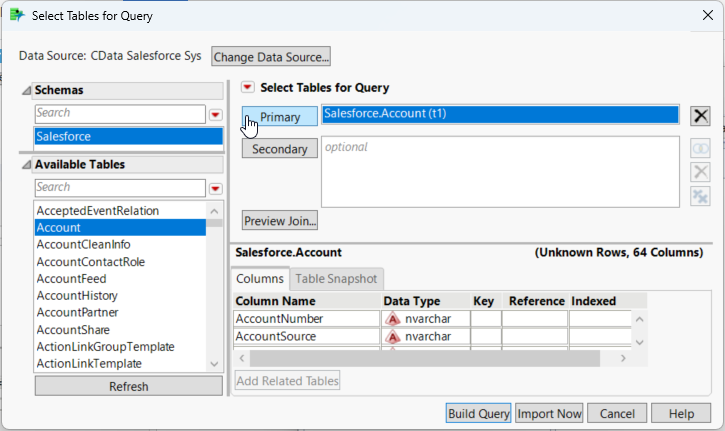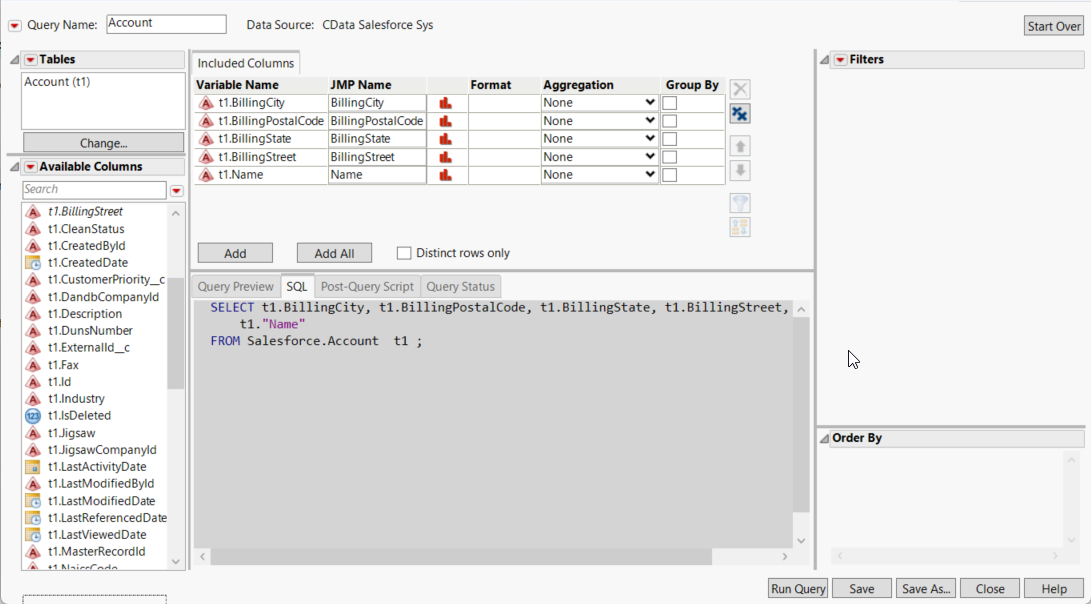Discover how a bimodal integration strategy can address the major data management challenges facing your organization today.
Get the Report →Use the CData ODBC Driver for Google Data Catalog in SAS JMP
You can use the CData ODBC Driver to integrate Google Data Catalog data into the statistical analysis tools available in SAS JMP. This article shows how to use Google Data Catalog data in the Graph Builder and Query Builder.
You can use the CData ODBC Driver for Google Data Catalog to integrate live data into your statistical analysis with SAS JMP. The driver proxies your queries directly to the Google Data Catalog API, ensuring that your analysis reflects any changes to the data. The CData ODBC Driver supports the standard SQL used by JMP in the background as you design reports.
This article shows how to access Google Data Catalog data into a report and create data visualization. It also shows how to use SQL to query Google Data Catalog data from the JMP Query Builder.
Access Google Data Catalog Data as an ODBC Data Source
If you have not already, first specify connection properties in an ODBC DSN (data source name). This is the last step of the driver installation. You can use the Microsoft ODBC Data Source Administrator to create and configure ODBC DSNs.
Google Data Catalog uses the OAuth authentication standard. Authorize access to Google APIs on behalf on individual users or on behalf of users in a domain.
Before connecting, specify the following to identify the organization and project you would like to connect to:
- OrganizationId: The ID associated with the Google Cloud Platform organization resource you would like to connect to. Find this by navigating to the cloud console.
Click the project selection drop-down, and select your organization from the list. Then, click More -> Settings. The organization ID is displayed on this page.
- ProjectId: The ID associated with the Google Cloud Platform project resource you would like to connect to.
Find this by navigating to the cloud console dashboard and selecting your project from the Select from drop-down. The project ID will be present in the Project info card.
When you connect, the OAuth endpoint opens in your default browser. Log in and grant permissions to the application to completes the OAuth process. For more information, refer to the OAuth section in the Help documentation.
When you configure the DSN, you may also want to set the Max Rows connection property. This will limit the number of rows returned, which is especially helpful for improving performance when designing reports and visualizations.
Import Google Data Catalog Data with the Query Builder
After you have created the Google Data Catalog DSN, you can use SQL to invoke the capabilities of the Google Data Catalog API. Follow the steps below to execute some supported queries in the Query Builder:
- In SAS JMP, click File -> Database -> Query Builder. The Select Database Connection dialog is displayed.
- Click New Connection.
- On the Machine Data Source tab, select the DSN. In the next step, the Select Tables for Query dialog is displayed.
- In the Available Tables section, select a table and click Primary.
- As you drag Available Columns to the Included Columns tab, the underlying SQL query is updated.
![The generated query in the Query Builder. (Salesforce is shown.)]()
- Click Run Query to display the data.
![The results of a query in the Query Builder. (Salesforce is shown.)]()
- To refresh the results with the current data, right-click Update from Database and click Run Script.
Visualize Google Data Catalog Data
After importing, you can use the Graph Builder to create graphs visually. To open the Graph Builder, click the Graph Builder button in the toolbar.
- Drag a dimension column onto the x axis. For example, Type.
- Drag a measure column onto the y axis. For example, DatasetName.
- Select a chart type. For example, a bar chart.
![Configuration of a basic chart. (Salesforce is shown.)]()









